Asteroid belt Study guides, Class notes & Summaries
Looking for the best study guides, study notes and summaries about Asteroid belt? On this page you'll find 74 study documents about Asteroid belt.
All 74 results
Sort by
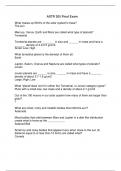 Popular
Popular
-
ASTR 205 Final Exam
- Exam (elaborations) • 7 pages • 2023
-
Available in package deal
-
- $10.00
- 1x sold
- + learn more
What makes up 99.8% of the solar system's mass? The sun Mercury, Venus, Earth and Mars are called what type of planets? Terrestrial Terrestrial planets are ________ in size and ______ in mass and have a _______ density of 3.9-5.5 g/cm3 Small; Low; High What terrestrial planet is the densest of them all. Earth Jupiter, Saturn, Uranus and Neptune are called what types of planets? Jovian Jovian planets are ______ is size, ______ in mass and have a _______ density of about 0.7-1.6 g/cm...
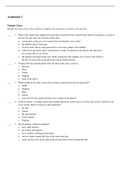
-
University of New South Wales (UNSW): PHYS 1160 Introduction to Astronomy Final Test Bank
- Exam (elaborations) • 222 pages • 2022
-
- $12.49
- 1x sold
- + learn more
1. What is the single most important reason that astronomers have learned more about our planetary system in the last 30 years than all of history before then. a. astronomers today are a lot smarter than astronomers were earlier b. the Hubble Space Telescope c. we have been able to send spacecraft to visit many planets and satellites d. radio telescope arrays allow astronomers to make out details on the planets that they have never been able to see before e. the planets (moving in their s...
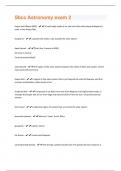
-
Sbcc Astronomy exam 2 Questions With 100% Correct Answers
- Exam (elaborations) • 10 pages • 2024
- Available in package deal
-
- $7.99
- + learn more
Kuiper belt Object (KBO) - A small body made of ice and rock that orbits beyond Neptune's orbit, in the Kuiper Belt. Exoplanet - a planet that orbits a star outside the solar system dwarf planet - Pluto (has 5 moons in KBO) Eris (has 5 moons) Ceres (in asteroid belt) asteroid belt - the region of the solar system between the orbits of Mars and Jupiter, where many asteroids are found Kuiper belt - A region of the solar system that is just beyond the orbit of Neptune and that contains sm...
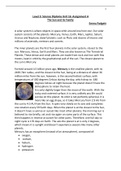
-
Unit 16 Assignment A
- Summary • 47 pages • 2022
-
Available in package deal
-
- $8.37
- 4x sold
- + learn more
Unit 16 Assignment A Overall Grade: Distinction Course Overall Grade: D*D Contains: Solar systems, Earth, Mercury, Venus, Mars, Jupiter, Saturn, Uranus, Neptune, Pluto, Ceres, Makemake, Haumea, Eris, Moons, Europa, Io, Ganymede, Titan, Big Bang theory, creation of solar system, stars, comets, life cycle of a comet, Keplers laws 1-3, compositions (C, S and M), asteroid belt, meteoroids, NASA, Oort clouds, radiation belts, gravity, sun, moon, earth, lunar months, moon cycle, solar eclipse,...
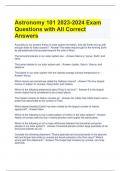
-
Astronomy 101 2023-2024 Exam Questions with All Correct Answers
- Exam (elaborations) • 23 pages • 2023
-
Available in package deal
-
- $13.99
- + learn more
Astronomy 101 2023-2024 Exam Questions with All Correct Answers According to our present theory of solar system formation, how did Earth end up with enough water to make oceans? - Answer-The water was brought to the forming Earth by planetesimals that accreted beyond the orbit of Mars. The terrestrial planets in our solar system are: - Answer-Mercury, Venus, Earth, and Mars. The jovian planets in our solar system are: - Answer-Jupiter, Saturn, Uranus, and Neptune. The planet in our so...
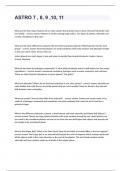
-
ASTRO 7 , 8, 9 ,10, 11 questions with answers 2024
- Exam (elaborations) • 7 pages • 2024
-
- $12.99
- + learn more
ASTRO 7 , 8, 9 ,10, 11What are the four major features of our solar system that provide clues to how it formed? Describe each one briefly. - correct answer Patterns of motion among large bodies, Two types of planets, asteroids and comets, exceptions to the rules. What are the basic differences between the terrestrial and jovian planets? Which planets fall into each group? - correct answer Terrestrial planets are small and dense with rocky surfaces and abundant metals in the core: Earth, Mars,...
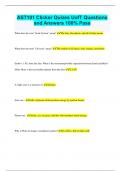
-
AST101 Clicker Quizes UofT Questions and Answers 100% Pass
- Exam (elaborations) • 32 pages • 2024
-
- $9.99
- + learn more
AST101 Clicker Quizes UofT Questions and Answers 100% Pass What does the term "Solar System" mean? The Sun, the planets, and all of their moons What does the term "Universe" mean? The totality of all space, time, energy, and matter Earth is 1 AU from the Sun. What is the maximumpossible separation between Earth and Mars? (Hint: Mars is the next farthest planet from the Sun) 2.5 AU A 'light year' is a measure of: distance Stars are... balls of plasma which produce energy ...
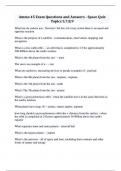
-
Ammo 45 Exam Questions and Answers - Space Quiz Topics 5,7,8,9
- Exam (elaborations) • 12 pages • 2023
-
Available in package deal
-
- $8.00
- + learn more
What law do rockets use - Newton's 3rd law, for every action there is an equal and opposite reaction What is the purpose of a satellite - communication, observation, mapping and navigation What is a low earth orbit - - an orbit that is completed in 1.5 hrs approximately 200-800km above the earth's surface What is the 4th planet from the sun - - mars The sun is an example of a... - star What are explosive, measuring devices or people examples of - payload What is the 8th planet from...
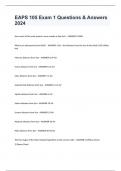
-
EAPS 105 Exam 1 Questions & Answers 2024
- Exam (elaborations) • 7 pages • 2024
-
Available in package deal
-
- $8.49
- + learn more
EAPS 105 Exam 1 Questions & Answers 2024 How much of the solar system's mass resides in the Sun? - ANSWER-99.86% What is an astronomical unit (AU)? - ANSWER-1 AU = the distance from the Sun to the Earth (150 million km) Mercury distance from Sun - ANSWER-0.39 AU Venus distance from Sun - ANSWER-0.72 AU Mars distance from Sun - ANSWER-1.5 AU Asteroid belt distance from Sun - ANSWER-2-3.5 AU Jupiter distance from Sun - ANSWER-5 AU Saturn distance from Sun - ANSWER-10 AU ...
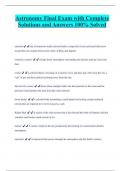
-
Astronomy Final Exam with Complete Solutions and Answers 100% Solved
- Exam (elaborations) • 11 pages • 2024
-
- $12.99
- + learn more
Astronomy Final Exam with Complete Solutions and Answers 100% Solved asteroid ️️any of numerous small celestial bodies composed of rock and metal that move around the sun (mainly between the orbits of Mars and Jupiter) coma(of a comet) ️️A large dusty atmosphere surrounding the nucleus mad up of gas and dust. comet ️️a celestial object consisting of a nucleus of ice and dust and, when near the sun, a "tail" of gas and dust particles pointing away from the sun. dust tail...

Do you wonder why so many students wear nice clothes, have money to spare and enjoy tons of free time? Well, they sell on Stuvia! Imagine your study notes being downloaded a dozen times for $15 each. Every. Single. Day. Discover all about earning on Stuvia


